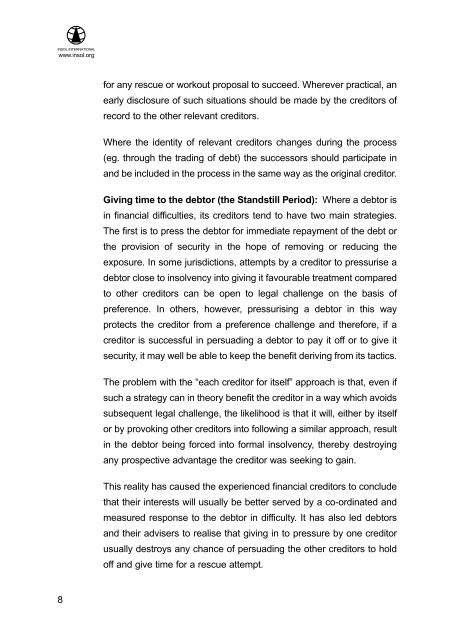statement of principles for a global approach to multi-creditor workouts
statement of principles for a global approach to multi-creditor workouts
statement of principles for a global approach to multi-creditor workouts
- No tags were found...
Create successful ePaper yourself
Turn your PDF publications into a flip-book with our unique Google optimized e-Paper software.
INSOL INTERNATIONALwww.insol.org<strong>for</strong> any rescue or workout proposal <strong>to</strong> succeed. Wherever practical, anearly disclosure <strong>of</strong> such situations should be made by the credi<strong>to</strong>rs <strong>of</strong>record <strong>to</strong> the other relevant credi<strong>to</strong>rs.Where the identity <strong>of</strong> relevant credi<strong>to</strong>rs changes during the process(eg. through the trading <strong>of</strong> debt) the successors should participate inand be included in the process in the same way as the original credi<strong>to</strong>r.Giving time <strong>to</strong> the deb<strong>to</strong>r (the Standstill Period): Where a deb<strong>to</strong>r isin financial difficulties, its credi<strong>to</strong>rs tend <strong>to</strong> have two main strategies.The first is <strong>to</strong> press the deb<strong>to</strong>r <strong>for</strong> immediate repayment <strong>of</strong> the debt orthe provision <strong>of</strong> security in the hope <strong>of</strong> removing or reducing theexposure. In some jurisdictions, attempts by a credi<strong>to</strong>r <strong>to</strong> pressurise adeb<strong>to</strong>r close <strong>to</strong> insolvency in<strong>to</strong> giving it favourable treatment compared<strong>to</strong> other credi<strong>to</strong>rs can be open <strong>to</strong> legal challenge on the basis <strong>of</strong>preference. In others, however, pressurising a deb<strong>to</strong>r in this wayprotects the credi<strong>to</strong>r from a preference challenge and there<strong>for</strong>e, if acredi<strong>to</strong>r is successful in persuading a deb<strong>to</strong>r <strong>to</strong> pay it <strong>of</strong>f or <strong>to</strong> give itsecurity, it may well be able <strong>to</strong> keep the benefit deriving from its tactics.The problem with the “each credi<strong>to</strong>r <strong>for</strong> itself” <strong>approach</strong> is that, even ifsuch a strategy can in theory benefit the credi<strong>to</strong>r in a way which avoidssubsequent legal challenge, the likelihood is that it will, either by itsel<strong>for</strong> by provoking other credi<strong>to</strong>rs in<strong>to</strong> following a similar <strong>approach</strong>, resultin the deb<strong>to</strong>r being <strong>for</strong>ced in<strong>to</strong> <strong>for</strong>mal insolvency, thereby destroyingany prospective advantage the credi<strong>to</strong>r was seeking <strong>to</strong> gain.This reality has caused the experienced financial credi<strong>to</strong>rs <strong>to</strong> concludethat their interests will usually be better served by a co-ordinated andmeasured response <strong>to</strong> the deb<strong>to</strong>r in difficulty. It has also led deb<strong>to</strong>rsand their advisers <strong>to</strong> realise that giving in <strong>to</strong> pressure by one credi<strong>to</strong>rusually destroys any chance <strong>of</strong> persuading the other credi<strong>to</strong>rs <strong>to</strong> hold<strong>of</strong>f and give time <strong>for</strong> a rescue attempt.8





